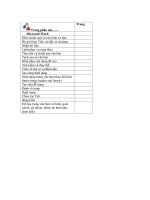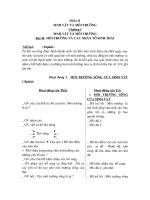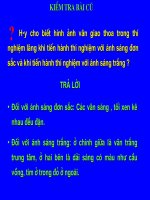tài liệu truyền hình số
Bạn đang xem bản rút gọn của tài liệu. Xem và tải ngay bản đầy đủ của tài liệu tại đây (7.73 MB, 644 trang )
Digital Television
Technology and Standards
John Arnold
Michael Frater
Mark Pickering
The University of New South Wales, ADFA
Canberra, ACT, Australia
Digital TelevisionDigital Television
Technology and Standards
John Arnold
Michael Frater
Mark Pickering
The University of New South Wales, ADFA
Canberra, ACT, Australia
Copyright © 2007 by John Wiley & Sons, Inc. All rights reserved
Published by John Wiley & Sons, Inc., Hoboken, New Jersey
Published simultaneously in Canada
No part of this publication may be reproduced, stored in a retrieval system, or transmitted in any form
or by any means, electronic, mechanical, photocopying, recording, scanning, or otherwise, except as
permitted under Section 107 or 108 of the 1976 United States Copyright Act, without either the prior
written permission of the Publisher, or authorization through payment of the appropriate per-copy fee
to the Copyright Clearance Center, Inc., 222 Rosewood Drive, Danvers, MA 01923, (978) 750-8400,
fax (978) 750-4470, or on the web at www.copyright.com. Requests to the Publisher for permission
should be addressed to the Permissions Department, John Wiley & Sons, Inc., 111 River Street,
Hoboken, NJ 07030, (201) 748-6011, fax (201) 748-6008, or online at />permission.
Limit of Liability/Disclaimer of Warranty: While the publisher and author have used their best efforts
in preparing this book, they make no representations or warranties with respect to the accuracy
or completeness of the contents of this book and specifi cally disclaim any implied warranties of
merchantability or fi tness for a particular purpose. No warranty may be created or extended by sales
representatives or written sales materials. The advice and strategies contained herein may not be
suitable for your situation. You should consult with a professional where appropriate. Neither the
publisher nor author shall be liable for any loss of profi t or any other commercial damages, including
but not limited to special, incidental, consequential, or other damages.
For general information on our other products and services or for technical support, please contact our
Customer Care Department within the United States at (800) 762-2974, outside the United States at
(317) 572-3993 or fax (317) 572-4002.
Wiley also publishes its books in a variety of electronic formats. Some content that appears in print
may not be available in electronic formats. For more information about Wiley products, visit our web
site at www.wiley.com.
Wiley Bicentennial Logo: Richard J. Pacifi co
Library of Congress Cataloging-in-Publication Data:
Arnold, John, 1954-
Digital television : technology and standards / by John Arnold, Michael
Frater, Mark Pickering.
p. cm.
ISBN 978-0-470-14783-2
1. Digital television. I. Frater, Michael II. Pickering, Mark
1966- III. Title.
TK6678.A77 2007
621.388Ј07–dc22 2007007077
Printed in the United States of America
10 9 8 7 6 5 4 3 2 1
This book is dedicated to our wives
Gemma Arnold
Emma Frater
Kim Pickering
whose support made possible both this book and our numerous
absences at international standards meetings which preceded it.
vii
Contents
Preface xv
1. Introduction to Analog and Digital Television 1
1.1 Introduction 1
1.2 Analog Television 1
1.2.1 Video 2
1.2.2 Audio 9
1.2.3 Systems 9
1.3 The Motivation for Digital Television 11
1.4 The Need for Compression 12
1.5 Standards for Digital Television 14
References 15
2. Characteristics of Video Material 17
2.1 Picture Correlation 17
2.2 Information Content 22
2.3 The Human Visual System 26
2.3.1 Perception of Changes in Brightness 27
2.3.2 Spatial Masking 28
2.3.3 Temporal Masking 28
2.3.4 Frequency Sensitivity 28
2.3.5 Tracking of Motion 29
2.3.6 Conclusion 29
2.4 Summary 30
Problems 30
MATLAB Exercise 2.1: Correlation Coeffi cient within a Picture 32
MATLAB Exercise 2.2: Correlation Coeffi cient between Pictures in a
Sequence 33
MATLAB Exercise 2.3: Entropy of a Picture 33
3. Predictive Encoding 35
3.1 Entropy Coding 35
3.1.1 Huffman Coding 35
3.1.2 Run Length Coding 41
3.2 Predictive Coding 41
3.3 Motion-Compensated Prediction 50
3.3.1 Motion Estimation 51
viii Contents
3.3.2 Motion-Compensated Prediction to Subpixel Accuracy 66
3.4 Quantization 68
3.5 Rate-Distortion Curves 73
3.6 Summary 74
Problems 75
MATLAB Exercise 3.1: Huffman Coding 80
MATLAB Exercise 3.2: Differential Pulse Code Modulation 81
MATLAB Exercise 3.3: Temporal Prediction and Motion Estimation 82
MATLAB Exercise 3.4: Fast Search Motion Estimation 84
4. Transform Coding 87
4.1 Introduction to Transform Coding 87
4.2 The Fourier Transform 89
4.3 The Karhunen–Loeve Transform 92
4.4 The Discrete Cosine Transform 100
4.4.1 Choice of Transform Block Size 105
4.4.2 Quantization of DCT Transform Coeffi cients 107
4.4.3 Quantization of DCT Coeffi cients Based on the Human
Visual System 110
4.4.4 Coding of Nonzero DCT Coeffi cients 113
4.5 Motion-Compensated DCT Encoders and Decoders 114
4.6 Rate Control 116
4.7 Conclusion 122
Problems 122
MATLAB Exercise 4.1: Eigenvectors of a Picture 126
MATLAB Exercise 4.2: Discrete Cosine Transform 127
MATLAB Exercise 4.3: Discrete Cosine Transform with Motion
Compensation 128
5. Video Coder Syntax 129
5.1 Introduction 129
5.2 Representation of Chrominance Information 129
5.3 Structure of a Video Bit Stream 132
5.3.1 The Block Layer 132
5.3.2 The Macroblock Layer 134
5.3.3 The Slice Layer 148
5.3.4 The Picture Layer 151
5.3.5 The Sequence Layer 151
5.4 Bit-Stream Syntax 151
5.4.1 Abbreviations 152
5.4.2 Start Codes 152
5.4.3 Describing the Bit-Stream Syntex 152
5.4.4 Special Functions within the Syntax 154
5.5 A Simple Bit-Stream Syntax 155
5.5.1 The Video Sequence Layer 155
Contents ix
5.5.2 The Picture Layer 157
5.5.3 The Slice Layer 158
5.5.4 The Macroblock Layer 159
5.5.5 The Block Layer 161
5.6 Conclusion 162
Problems 162
MATLAB Exercise 5.1: Effi cient Coding of Motion Vector Information 167
MATLAB Exercise 5.2: A Simple Video Encoder 167
MATLAB Exercise 5.3: A Simple Video Decoder 168
MATLAB Exercise 5.4: A Video Encoder 168
MATLAB Exercise 5.5: A Video Decoder 169
MATLAB Exercise 5.6: Intra/Inter/Motion-Compensated Coding of
Macroblocks 169
6. The MPEG-2 Video Compression Standard 171
6.1 Introduction 171
6.2 Picture Types in MPEG-2 173
6.3 The Syntax of MPEG-2 179
6.3.1 Extension Start Code and Extension Data 180
6.3.2 Sequence Layer 181
6.3.3 The Group of Pictures Layer 187
6.3.4 The Picture Layer 188
6.3.5 The Slice Layer 198
6.3.6 The Macroblock Layer 200
6.3.7 The Block Layer 221
6.4 Video Buffer Verifi er 223
6.5 Profi les and Levels 227
6.5.1 Profi les 227
6.5.2 Levels 229
6.6 Summary 229
Problems 229
MATLAB Exercise 6.1: Bidirectional Motion-Compenseted Prediction 233
MATLAB Exercise 6.2: Dual-Prime Motion-Compensated Prediction 233
MATLAB Exercise 6.3: Field and Frame Motion-Compensated
Prediction 234
MATLAB Exercise 6.4: Field and Frame DCT Coding 235
7. Perceptual Audio Coding 237
7.1 The Human Auditory System 238
7.1.1 Outer Ear 239
7.1.2 Middle Ear 239
7.1.3 Inner Ear 240
7.2 Psychoacoustics 244
7.2.1 Sound Pressure Level 244
7.2.2 Auditory Thresholds 244
x Contents
7.2.3 The Critical Bandwidth and Auditory Filters 246
7.2.4 Auditory Masking 248
7.3 Summary 251
Problems 251
References 252
8. Frequency Analysis and Synthesis 253
8.1 The Sampling Theorem 253
8.2 Digital Filters 255
8.3 Subband Filtering 256
8.3.1 The Analysis Filter Bank 256
8.3.2 The Synthesis Filter Bank 258
8.3.3 Filters for Perfect Reconstruction 259
8.4 Cosine-Modulated Filters 260
8.5 Effi cient Implementation of a Cosine-Modulated Filterbank 265
8.5.1 Analysis Filter 265
8.5.2 Synthesis Filter 270
8.6 Time-Domain Aliasing Cancellation 274
8.7 Summary 280
Problems 280
MATLAB Exercise 8.1 282
MATLAB Exercise 8.2 283
References 284
9. MPEG Audio 285
9.1 MPEG-1 Layer I,II Encoders 287
9.1.1 Analysis Filterbank 288
9.1.2 Scalefactor Calculation 288
9.1.3 Psychoacoustic Model 1 291
9.1.4 Dynamic Bit Allocation 307
9.1.5 Coding of Bit Allocation 310
9.1.6 Quantization and Coding of Subband Samples 311
9.1.7 Formatting 312
9.2 Layer II Encoder 314
9.2.1 Analysis Filterbank 315
9.2.2 Scalefactor Calculation 315
9.2.3 Coding of Scalefactors 315
9.2.4 Dynamic Bit Allocation 317
9.2.5 Coding of Bit Allocation 319
9.2.6 Quantization and Coding of Subband Samples 319
9.2.7 Ancillary Data 321
9.2.8 Formatting 321
9.3 Joint Stereo Coding 322
9.4 MPEG-1 Syntax 323
9.4.1 Audio Sequence Layer 323
9.4.2 Audio Frame 323
Contents xi
9.4.3 Header 324
9.4.4 Error Check 328
9.4.5 Audio Data, Layer I 328
9.4.6 Audio Data, Layer II 328
9.5 MPEG-1 Layer I, II Decoders 328
9.5.1 Bit Allocation Decoding 328
9.5.2 Scalefactor Selection Information Decoding 331
9.5.3 Scalefactor Decoding 331
9.5.4 Requantization of Subband Samples 332
9.5.5 Synthesis Filterbank 333
9.6 MPEG-2 333
9.6.1 Backwards-Compatible MPEG-2 Frame Formatting 333
9.6.2 Matrixing Procedures for Backwards Compatibility 335
9.7 Summary 335
Problems 336
MATLAB Exercise 9.1 338
MATLAB Exercise 9.2 339
MATLAB Exercise 9.3 340
References 340
10. Dolby AC-3 Audio 341
10.1 Encoder 343
10.1.1 Audio Input Format 344
10.1.2 Transient Detection 345
10.1.3 Forward Transform 346
10.1.4 Channel Coupling 349
10.1.5 Rematrixing 356
10.1.6 Extract Exponents 359
10.1.7 Encode Exponents 363
10.1.8 Bit Allocation 364
10.1.9 Quantize Mantissas 381
10.1.10 Dialog Normalization 386
10.1.11 Dynamic Range Compression 387
10.1.12 Heavy Compression 389
10.1.13 Downmixing 390
10.2 Syntax 397
10.2.1 Syntax Specifi cation 397
10.3 Decoder 410
10.3.1 Decode Exponents 410
10.3.2 Bit Allocation 412
10.3.3 Decode Coeffi cients 413
10.3.4 Decoupling 414
10.3.5 Inverse Transform 414
10.3.6 Overlap and Add 415
10.4 Summary 415
Problems 415
MATLAB Exercise 10.1 419
xii Contents
MATLAB Exercise 10.2 419
MATLAB Exercise 10.3 420
References 420
11. MPEG-2 Systems 421
11.1 Introduction 421
11.2 Service Overview 422
11.3 Multiplexer Structure 425
11.3.1 PES Sublayer 425
11.3.2 Transport Stream Sublayer 428
11.3.3 Program Stream Sublayer 434
11.4 Timing 434
11.4.1 System Time Clock 435
11.4.2 Clock References and Reconstruction of the STC 435
11.4.3 Time Stamps 437
11.5 Buffer Management 437
11.6 Program-Specifi c Information 439
11.6.1 MPEG-2 Descriptors 439
11.6.2 MPEG-2 Tables 453
11.6.3 Overheads Due to PSI 458
11.7 MPEG-2 Decoder Operation 459
11.7.1 Synchronization to Transport Stream 459
11.7.2 PSI Decoding 459
11.7.3 Program Reassembly 459
11.8 Use Of MPEG-2 Systems In Digital Television 463
11.8.1 Use of MPEG-2 Systems in ATSC 463
11.8.2 Use of MPEG-2 Systems in DVB 464
11.8.3 Implementation of PSI in DVB 465
11.9 Conclusion 465
Problems 465
References 469
12. DVB Service Information and ATSC Program and System
Information Protocol 471
12.1 Introduction 471
12.2 Why SI and PSIP? 471
12.3 DVB-SI 472
12.3.1 DVB Common Data Formats 474
12.3.2 DVB Descriptors 476
12.3.3 DVB Tables 492
12.3.4 DVB Delivery Issues 500
12.4 ATSC Program and System Information Protocol 501
12.4.1 Common Data Formats 502
12.4.2 ATSC Descriptors 504
12.4.3 ATSC Tables 508
12.5 DVB SI and ATSC PSIP Interoperability 516
12.5.1 PIDs 517
Contents xiii
12.5.2 Use of table_id 517
12.5.3 Use of descriptor_tag 517
12.6 Conclusion 517
Problems 517
MATLAB Exercise 12.1 523
References 524
13. Digital Television Channel Coding and Modulation 525
13.1 Introduction 525
13.2 Generic Concepts 525
13.2.1 Channel Characteristics and Intersymbol Interference 526
13.2.2 Modulation 528
13.2.3 Equalization 532
13.2.4 Randomization 535
13.2.5 Channel Coding Technology 537
13.3 Channel Coding and Modulation for ATSC 545
13.3.1 ATSC 8-VSB Modulation 545
13.3.2 ATSC Data Framing 546
13.3.3 ATSC Concatenated Channel Coder 547
13.3.4 ATSC Channel Capacity 550
13.4 Channel Coding and Modulation for DVB 550
13.4.1 DVB Modulation 550
13.4.2 DVB Channel Coding 562
13.4.3 DVB Channel Capacity 566
13.5 Conclusion 566
Problems 566
MATLAB Exercise 13.1 569
MATLAB Exercise 13.2 569
MATLAB Exercise 13.3 570
References 570
14. Closed Captioning, Subtitling, and Teletext 571
14.1 Introduction 571
14.2 DVB Subtitles and Teletext 571
14.2.1 Subtitles 572
14.2.2 Teletext 581
14.3 ATSC Closed Captioning 587
14.3.1 Line 21 Data Service 587
14.3.2 Advanced Television Closed Captioning 592
14.4 Conclusion 603
Problems 603
References 604
Appendix. MPEG Tables 605
Index 617
xv
Preface
In the last 50 years, television has arguably become the dominant source of enter-
tainment and information in many countries. In the western world, most households
own at least one television. Many have two or more. Over this half century, television
technology has proved to be very adaptable, able to accommodate upgrades taking
advantage of new technology without requiring existing receivers to be replaced.
Indeed, a 50-year-old television receiver could still be used in most countries. The
maintenance of compatibility with the existing receivers has been achieved through
incremental improvements in service quality. The transitions from black-and-white
to color television and from mono to stereo audio are both examples of this.
Digital television offers a number of potential advantages over the older, ana-
log technology. High-defi nition services, providing much greater resolution than the
conventional standard-defi nition television, are possible, as is the packing of several
standard defi nition programs into the same bandwidth as a single analog television
channel. The current international move to digital television is more revolutionary
in nature than the previous changes, requiring the phasing-in of digital receivers and
the subsequent phasing-out of the existing analog receivers. Consumers will there-
fore be required to purchase new equipment, in the form of a digital television or
a decoder, to convert digital signals into a form that can be passed to their existing
analog receiver.
This book describes the technology and standards behind digital television. It
introduces the basic techniques used in video coding, audio coding, and systems,
which provide for the multiplexing of these services and other ancillary data into a
single bit stream. The description of standards covers the north-American Advanced
Television System Committee (ATSC) and the European Digital Video Broadcasting
(DVB). Aspects relating to these standards are described independently, allowing
the reader to cover only those parts relevant to one system if desired.
The fi rst chapter provides an introduction to analog and digital television,
setting up the basic division of functionality into the representation of video, the
representation of audio, and the underlying systems that provide services such as
multiplexing of video and audio onto a single channel and modulation. The remain-
ing chapters are grouped into three parts, covering the video, audio, and systems
aspects of digital television, respectively. Each of these parts is written so that it
can be read independent of the other parts. The fi rst part deals with the coding of
digital video signals using the MPEG-2 standard to produce a compressed digital
video bit stream.
Chapter 2 describes the characteristics of video material. Chapters 3 and 4
describe the signal processing used to reduce the spatial and temporal redundancy
of digital video signals, with Chapter 3 describing predictive coding and Chapter 4
transform coding. Chapter 5 describes the principles behind the syntax used to rep-
resent the various data elements carried in a compressed video bit stream, whereas
Chapter 6 introduces the specifi c features of the MPEG-2 video standard.
The second part covers the coding and compression of digital audio, using a
similar structure to the fi rst part. Chapter 7 introduces the aspects of the human ear
that are critical in determining subjective audio quality, followed in Chapter 8 by a
description of the signal processing used for digital audio compression, including
the use of subband fi lter banks in audio coding. Chapters 9 describes the specifi c
methods used by the MPEG-1 and MPEG-2 standards, respectively, with Chapter 10
describing the Dolby AC-3 system used primarily by ATSC.
The third part describes the modulation of digital television services for trans-
mission, the system protocols used for multiplexing, timing, and control, and the
other components of a digital television service that provide a range of data services,
including closed captioning (also known as subtitling) and teletext. In this part,
separate descriptions are provided for the different techniques provided by DVB
and ATSC. Chapter 11 describes MPEG-2 systems, which provide the multiplexing,
timing, control data for digital television. MPEG-2 systems also carry a collection
of data, known as program-specifi c information, which describes the contents of
a systems’ bit stream. ATSC and DVB each provide its own extensions to the pro-
gram-specifi c information, which are described separately in Chapter 12. Chapter
13 describes the terrestrial broadcast modulation schemes of ATSC and DVB, in-
cluding the use of channel coding to protect bit streams from errors introduced in
transmission. Finally, the closed-captioning and teletext systems are described in
Chapter 14.
This book might be used as a textbook supporting a variety of different types
of courses. An undergraduate digital television course might be based on a selec-
tion of material from Chapters 1–3, 5, 6, and 11. A postgraduate course in digital
television, for which background in digital signal processing and digital com-
munications theory is assumed, could extend this to include all material from
Chapters 1–3 on video, 5 and 6 on audio, and 10 and 11 on systems, incorporating
selections from other chapters. A more specialized course on video coding could
be based on Chapters 1–5.
J
OHN ARNOLD
MICHAEL FRATER
MARK PICKERING
Canberra, Australia
June 2007
xvi Preface
1
Digital Television, by John Arnold, Michael Frater and Mark Pickering.
Copyright © 2007 John Wiley & Sons, Inc.
Chapter 1
Introduction to Analog
and Digital Television
1.1. INTRODUCTION
From small beginnings less than 100 years ago, the television industry has grown
to be a signifi cant part of the lives of most people in the developed world, providing
arguably the largest single source of information to its viewers.
The fi rst true television system was demonstrated by John Logie Baird in the
1920s. Further experiments were conducted in the following decade, leading to trial
broadcasts in Europe and the United States, and eventually to the regular televi-
sion service we know today. Originally, only monochrome pictures were supported.
Color television was introduced in the United States in 1954 and in Europe in 1967.
Television systems have evolved as simplex transmission systems, as shown in
Figure 1.1. The term simplex means that information fl ows only in one direction
across the channel. A transmitter, whose antenna is usually mounted on a tall tower,
broadcasts a signal to a large number of receivers. Each receiver decodes the trans-
mission and passes it on to a display device. Sometimes, the receiver and display are
integrated into a single device, such as in a standard television that incorporates a
means for the user to select the channel to be viewed. Sometimes, the receiver and
display are separate devices, such as when a signal is received through a video cas-
sette recorder (VCR) and passed to an external display. This system is known as
terrestrial broadcast television.
Satellite and cable television systems operate on similar models. Figure 1.2
shows the outline structure of a cable television system.
1.2. ANALOG TELEVISION
Traditional television services make use of analog technology to provide an audio-
visual, broadcast service. The basic structure of an analog television transmitter
is shown in Figure 1.3. Video and audio signals, which may be derived from live
sources such as cameras and microphones or from storage devices such as video
2 Chapter 1 Introduction to Analog and Digital Television
recorders, are fed into separate modulators, whose output is multiplexed and upcon-
verted to form the broadcast signal.
Various methods of modulating, multiplexing, and upconverting the signals to spe-
cifi c broadcast frequencies (as shown in Figure 1.3) are defi ned in the various analog
television standards. Three of the major standards used for analog television are National
Television System Committee (NTSC) [1], used primarily in North, Central, and South
America, Systeme Electronique (pour) Couleur avec Memoire (SECAM), used in France
and countries in eastern Europe such as Poland and Russia, and Phase Alternating Line
(PAL) [2], used in many other countries including western Europe and Australia.
In this chapter, we discuss the operation of analog television with reference to
three areas: the representation of video, the representation of audio, and the systems
that provide the multiplexing of video and audio services into a single channel.
1.2.1. Video
An analog video signal is created by a time sequence of pictures, with 25 or 30 of
these pictures displayed every second. Each picture consists of a number of lines,
Transmitter
Video/audio
signal
Receiver Display
Receiver Display
Receiver Display
Figure 1.1 Simplex structure of terrestrial broadcast television.
Figure 1.2 Structure of a cable television system.
Transmitter/
multiplexer
Video/audio
signal
Video/audio
signal
Receiver Display
Receiver Display
Receiver
Display
Cable distribution network
1.2. Analog Television 3
each of which is scanned left to right, as illustrated in Figure 1.4. The vertical
resolution is usually 576 lines for 25 Hz systems and 480 lines for 30 Hz systems.
In addition to the displayed lines, a number of other lines of data are transmitted.
These are intended to provide time for the scan in a cathode ray tube to return from
the bottom right of the display at the end of one picture to the top left of the display
at the beginning of the next picture. The inclusion of these nondisplayed lines brings
the total number of lines per picture to 625 for 25 Hz systems and 525 for 30 Hz
systems. The time in which these nondisplayed lines are transmitted is known as the
vertical blanking interval (VBI).
1.2.1.1. Horizontal Synchronization
In an analog television signal, a synchronization pulse is provided at the start of
every line in the picture as shown in Figure 1.5, which shows the waveform for a
single line where the brightness decreases in steps from left to right. This means that
the display begins its horizontal scan at the same place in the signal as the camera
that captured the video signal. In addition, a longer synchronization pulse is used to
indicate that the scan should restart at the top left of the display. These synchroniza-
tion pulses allow the receiver to achieve synchronism with the incoming signal.
Video
camera
Microphone
Modulator
Modulator
Multiplexer
Upconverter
Figure 1.3 Basic structure of an analog television system.
First, scan left to right
Second, scan top to bottom
Figure 1.4 Simple left-to-right, top-to-bottom scan.
4 Chapter 1 Introduction to Analog and Digital Television
The interval allocated for transmission of the line synchronization pulse and the
immediately surrounding regions (known as the front and back porches) is known as
the line blanking interval or the horizontal blanking interval. Its length is 11 µs in
NTSC and 12 µs in PAL and SECAM systems.
1.2.1.2. Horizontal Resolution
The horizontal resolution of an analog television system depends on the bandwidth
of the video signal. Roughly speaking, the resolution of the system is 2 pixels per
Hertz of video bandwidth. These pixels are shared equally between the transmitted
lines. The number of useful pixels in each line is reduced by the length of the line
blanking interval. The horizontal resolution r
h
of an analog video system with band-
width B is therefore
r
h
ϭ 2 Bt
ULI
where t
ULI
is the useful line interval. The horizontal resolutions for a number of
in-service analog television systems are shown in Table 1.1. In the case of PAL
and SECAM, there are a number of different implementations, each denoted by a
Video line
Line
synch
pulse
Figure 1.5 Waveform of a single picture line of analog video.
Table 1.1 Approximate horizontal resolution for selected analog television systems.
System
Lines per
second
(KHz)
Line
period
(
µs)
Useful line
interval (line
period – line
blanking interval)
(
µs)
Video
bandwidth
(B) (MHz)
Approximate
horizontal
resolution
(pixels)
NTSC 15.750 63.5 52.5 4.2 441
PAL (B, G, H)/
SECAM (B, G)
15.625 64.0 52 5.0 520
PAL (I) 15.625 64.0 52 5.5 572
PAL (D)/SECAM
(D, K, K1, L)
15.625 64.0 52 6.0 624
1.2. Analog Television 5
single letter. The video bandwidth varies between implementations, and a number
of options are shown.
1.2.1.3. Interlaced Video
When analog television was designed, an important design trade-off was between
the service picture rate and the service bandwidth. The picture rate chosen needs to
be suffi ciently fast to ensure that a human viewer perceives an apparently continuous
service (as opposed to a rapid series of individual pictures—called fl icker—which
would be subjectively most unpleasant). Once the appropriate horizontal and vertical
resolution of a television picture had been decided, the desired bandwidth meant that
a relatively low picture rate (25 or 30 Hz) was all that could be achieved. These
picture rates are insuffi cient to avoid fl icker in all circumstances. However, simply
increasing the picture rate would lead to an increase in the required service bandwidth.
This was an unacceptable outcome. The developers of analog television overcame
this problem using a technique called interlacing.
Interlacing divides each picture into two fi elds, as shown in Figure 1.6. One fi eld
contains the odd lines from the picture (i.e., lines 1, 3, 5, …) and is called the odd
fi eld, whereas the other fi eld contains the even lines from the picture (i.e., lines 2, 4,
6,…) and is called the even fi eld (Figure 6(a)). The odd lines are scanned from the
camera system and then half a picture time later (i.e., 1/50th or 1/60th of a second)
the even lines are scanned (Figure 6(b)). This approach improves the rendition of
moving objects and also completely removes the fl icker problem discussed earlier.
The trade-off is some loss in vertical resolution of the picture.
(a)
(b)
Odd (top) field
Even (bottom) field
Time
Figure 1.6 Interlace structure showing location of odd and even fi elds, (a) as seen on the display,
and (b) the formation of pictures from two consecutive fi elds.
6 Chapter 1 Introduction to Analog and Digital Television
Table 1.2 shows the number of lines per picture and fi eld for 25 and 30 Hz
analog television systems.
EXAMPLE 1.1—MATLAB
The aim of this example is to demonstrate the impact of combining two fi elds containing a
moving object into a single picture.
SOLUTION Figure 1.7 shows two fi elds of 128 ϫ 128 pixels consisting of a black background
and a white square of size 32 ϫ 32 pixels that has moved four pixels to the right between fi elds.
A ϭ zeros(128); % black background for odd fi eld
B ϭ zeros(128); % black background for even fi eld
A(49:80, 49:80) ϭ 255 ϫ ones(32); % white square in odd fi eld
B(49:80, 57:88) ϭ 255 ϫ ones(32); % white square in even fi eld
(moved 8 pixels right)
The individual fi elds can be displayed using the MATLAB function image.m:
image(A) % display odd fi eld
image(B) % display even fi eld
The images obtained by displaying A and B are shown in Figure 1.7.
The two fi elds can be merged into a single picture, which is then displayed, using the
commands below.
C ϭ zeros(256,128);
C(1:2:255,:) ϭ A;
C(2:2:256,:) ϭ B;
image(C);
Table 1.2 Numbers of video lines per field and picture.
System
Notional
picture
frequency
Hz
Field
frequency
Hz
Displayed
lines per
picture
Displayed
lines per
field
Total
lines per
picture
Total lines
per field
PAL,
SECAM
25 50 576 288 625 313 (odd)/
312 (even)
NTSC 30 60 480 240 525 263 (odd)/
262 (even)
Figure 1.7 Odd and even fi elds produced in Example 1.









